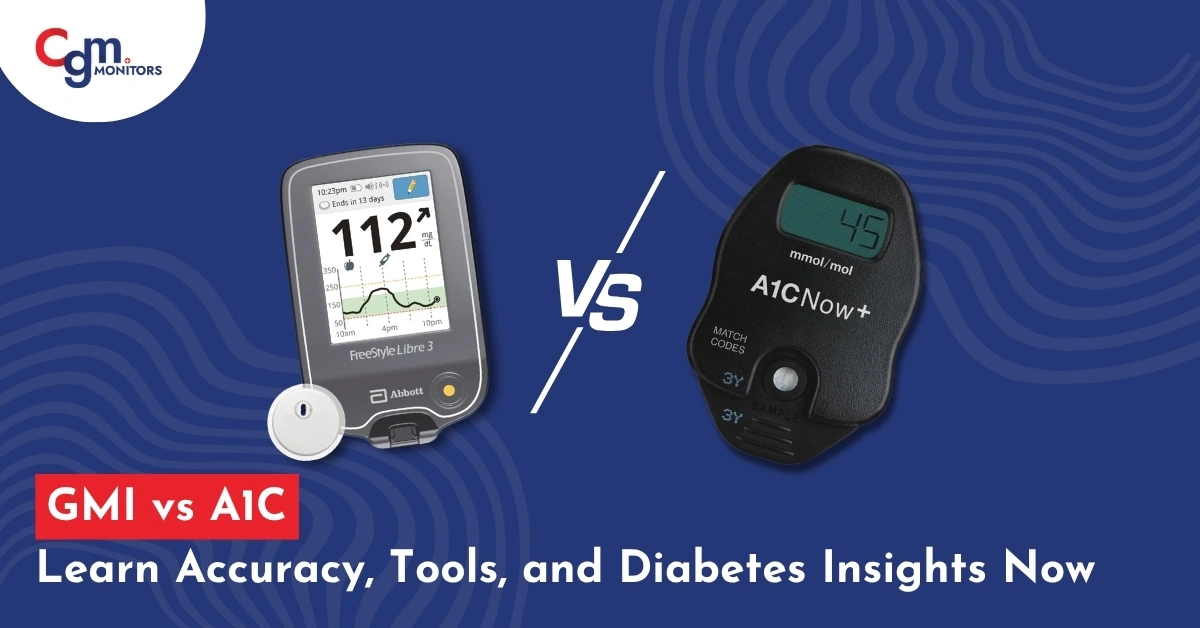Table of content
- What is GMI vs A1c and Why it Matters
- What Is A1C? (Your Long-Term Blood Sugar Score)
- What Is GMI? (Your CGM-Based Estimated A1C)
- How GMI Is Calculated (Simple Example for Patients)
- Why GMI and A1C Don’t Always Match
- How Doctors Use A1C vs GMI (Explained for Patients)
- Which Is More Accurate: A1C or GMI?
- CGM Devices That Show GMI (Best Options for Patients)
- Benefits of Tracking GMI Daily (For Diabetic Patients)
- Can GMI Replace A1C? (Patient-Friendly Answer)
- Final Thoughts: What Every Diabetic Patient Should Remember
- Frequently Asked Questions
What is GMI vs A1c and Why it Matters
When managing diabetes, two major indicators—GMI (Glucose Management Indicator) and A1C (Hemoglobin A1C)—play a vital role in understanding long-term and real-time blood sugar trends. Although both focus on average glucose, they differ in how they are calculated, the timeframe they represent, and their clinical uses.
This detailed guide breaks down GMI vs A1C, explains how GMI is calculated using CGM devices like the latest Dexcom G7 and Freestyle Libre 2 plus, and provides expert insights to help you interpret both metrics together for better diabetes control.
By the end, you will understand:
- What A1C and GMI really mean
- Why they may not match
- Which one is more accurate for daily life
- How your CGM device calculates GMI
- How both numbers help you stay in control of your diabetes
What Is A1C? (Your Long-Term Blood Sugar Score)
Your A1C is a blood test that shows your average blood sugar over the past 2–3 months.
Doctors rely on it because it:
- Helps diagnose diabetes
- Shows long-term glucose trends
- Predicts risk of complications
- Guides medication decisions
Because red blood cells live around 120 days, A1C is a long-term picture of your control—not just one day or one week.
What Is GMI? (Your CGM-Based Estimated A1C)
If you use a CGM like Dexcom or FreeStyle Libre, you may have seen a number called GMI (Glucose Management Indicator). GMI is not a lab test. It’s an estimate of what your A1C would be based on your last 10–14 days of glucose readings.
That means:
- GMI updates every day
- It shows what’s happening right now
- It reacts quickly to changes in food, insulin, activity, and stress
For many diabetic patients, GMI is easier to understand because it reflects your daily habits.
How GMI Is Calculated (Simple Example for Patients)
GMI uses a simple formula:
GMI (%) = 3.31 + (0.02392 × your average CGM glucose)
Example
If your average CGM reading is 150 mg/dL, then:
- 150 × 0.02392 = 3.588
- 3.588 + 3.31 = 6.9%
So your GMI would be 6.9%, meaning your CGM predicts your A1C is around that number.
What about 7.7 GMI to A1C?
A GMI of 7.7% roughly equals an A1C of 7.7%, showing average glucose slightly above the recommended target. Understanding this conversion helps you track your CGM readings against lab-tested A1C for better diabetes management.
Why GMI and A1C Don’t Always Match
Many diabetic patients get confused when they see their GMI and A1C looking very different.
This is normal.
Reasons They May Differ
- Different time periods (GMI = 2 weeks, A1C = 3 months)
- CGM accuracy issues (sensor errors, compression, early-wear periods)
- Red blood cell problems affecting A1C
- Changes in lifestyle—diet, exercise, stress
- Recent medication changes
When GMI > A1C
This means your blood sugar recently went higher.
When GMI < A1C
This means your blood sugar recently got better, or your A1C is affected by anemia or low RBC lifespan.
How Doctors Use A1C vs GMI (Explained for Patients)
Both numbers matter, and your doctor looks at them for different reasons.
A1C Helps Your Doctor:
- Diagnose diabetes or prediabetes
- Check if your long-term control is good
- Adjust long-term medications like metformin, GLP-1, insulin, SGLT2, etc.
- Predict future complications (eyes, kidneys, nerves, heart)
GMI Helps Your Doctor:
- Adjust insulin doses quickly
- Track your daily highs and lows
- Understand how food affects your glucose
- Prevent hypoglycemia
- Improve your Time In Range (TIR)
Expert Insight
“A1C tells me where a patient has been. GMI tells me where they are going.
For CGM users, GMI is essential for day-to-day control.”
— Dr. Maria Hunt, Endocrinologist & Diabetes Educator
Which Is More Accurate: A1C or GMI?
A1C is more accurate for long-term control.
Backed by decades of research, it’s still the gold standard.
GMI is more accurate for daily decision-making.
If you want to understand how your:
- meals
- insulin
- exercise
- sleep
- stress
affect your blood sugar today, then GMI is more useful.
According to studies Diabetes Care Journal, GMI and A1C usually differ by 0.3–0.5%, but bigger differences are common.
CGM Devices That Show GMI (Best Options for Patients)
Dexcom G7
- Shows GMI directly in the app
- Fastest warm-up time
- Great accuracy (MARD ~8.2%)
- Alerts for highs and lows
FreeStyle Libre 2 Plus & Libre 3 Plus
- Real-time glucose data
- 14-day sensor
- Shows estimated A1C and averages
- No fingerstick calibration required
CGMs are becoming the easiest way for diabetic patients to manage their condition without constant finger-pricks.
Benefits of Tracking GMI Daily (For Diabetic Patients)
1. Understanding Your Blood Sugar Patterns
You’ll see:
- Why you spike after certain meals
- Why mornings are high (dawn phenomenon)
- When you tend to go low
2. Helps Prevent Hypoglycemia
CGMs offer alerts to stop dangerous lows in advance.
3. Helps Improve Your Time in Range (TIR)
TIR is now considered just as important as A1C.
4. Guides Healthier Daily Choices
You can see instantly how:
- a walk improves your sugar
- a big meal spikes it
- stress raises glucose levels
5. Supports Better Mental Health
Patients report feeling:
- less anxious
- more confident
- more in control
- Because they finally understand what their blood sugar is doing.
Can GMI Replace A1C? (Patient-Friendly Answer)
No — GMI cannot replace A1C. They work together, not separately.
- A1C shows your long-term control
- GMI shows your daily patterns
If you use both, you’ll have a complete picture of your diabetes health.
Final Thoughts: What Every Diabetic Patient Should Remember
Both GMI and A1C are important tools, but they serve different purposes:
- A1C tells you your average over 3 months
- GMI reflects your recent 10–14 days
Using both helps you and your doctor understand your diabetes better and adjust your treatment more accurately.
If you use Dexcom G6, Dexcom G7, or FreeStyle Libre 3 Plus, monitoring your GMI daily can help you:
- improve your glucose control
- reduce highs and lows
- understand how lifestyle affects your sugar
- stay healthier and more stable
With the right tools, diabetes management becomes simpler, more predictable, and less stressful.
Frequently Asked Questions
What is a good GMI score?
Most doctors aim for a GMI of 7% or lower for people with diabetes. A lower GMI means your glucose has been more stable and closer to your target range.
How do I convert GMI to A1C?
GMI is already reported in A1C-equivalent % units; no conversion is needed. The formula used by Dexcom/FreeStyle Libre is GMI (%) = 3.31 + 0.02392 × [mean glucose in mg/dL].
How to lower GMI levels?
Lower average glucose through better diet (lower carbs), more activity, weight loss, medication adjustments, and reducing glucose spikes.
Does drinking water lower your A1C?
Indirectly—staying hydrated can slightly lower glucose concentration, but it doesn’t meaningfully change true A1C or GMI.
What are the new A1C guidelines for seniors?
ADA 2024–2025: <7.0–7.5% for healthy seniors; <8.0–8.5% for frail, multiple comorbidities, or limited life expectancy to avoid hypoglycemia.
Will losing 20 pounds lower my A1C?
Yes, almost always—5–10% body weight loss (often ~15–25 lb for most adults) typically drops A1C 0.5–2.0 points in type 2 diabetes or prediabetes.
Can exercise lower GMI?
Yes—regular aerobic and resistance exercise can lower average glucose and GMI by 0.3–1.0% within weeks.
Why is my GMI higher than my A1C?
Common reasons: recent worsening of glucose control, high-glycemic variability, or conditions that falsely lower lab A1C (iron-deficiency anemia, recent bleeding, chronic liver disease).
Which is more accurate, GMI or A1C?
Neither is universally “more accurate”; they measure different things. GMI is more precise for recent glucose patterns in CGM users; lab A1C is the gold-standard diagnostic test but can be skewed by anemia, kidney disease, or hemoglobin variants.







Write a comment
Your email address will not be published. All fields are required